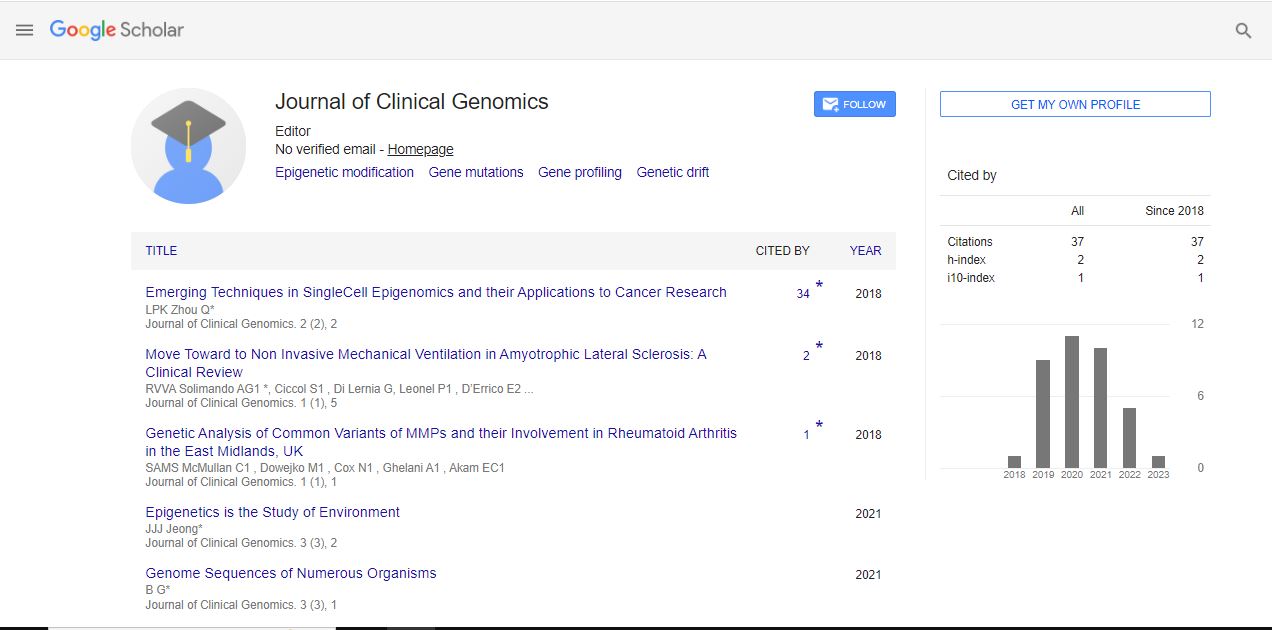Opinion Article, J Chromatography Res Vol: 6 Issue: 4
Microscale and Nanoscale Chromatography: Miniaturizing Analytical Techniques for Precision and Sensitivity
Paul Y Staz*
1Department of Chemistry, University College Cork, Cork, Ireland
*Corresponding Author: Paul Y Staz,
Department of Chemistry, University
College Cork, Cork, Ireland
E-mail: Paulystaz456321@gmail.com
Received date: 27 November, 2023, Manuscript No. JCGR-24-123803;
Editor assigned date: 29 November, 2023, Pre QC No. JCGR-24-123803 (PQ);
Reviewed date: 14 December, 2023, QC No. JCGR-24-123803;
Revised date: 21 December, 2023, Manuscript No. JCGR-24-123803 (R);
Published date: 28 December, 2023, DOI:10.36648/JCGR.1000077.
Citation: Staz PY (2023) Microscale and Nanoscale Chromatography: Analytical Techniques for Precision and Sensitivity. J Chromatography Res 6:4.
Description
Chromatography, a powerful separation technique, has undergone significant evolution with the advent of microscale and nanoscale chromatography. These miniaturized chromatographic techniques have emerged as revolutionary tools, offering enhanced sensitivity, reduced sample and solvent consumption, faster analysis times, and increased resolution.
Principles of microscale and nanoscale chromatography
Microscale and nanoscale chromatography involve the downsizing of conventional chromatographic methods, such as Liquid Chromatography (LC) and Gas Chromatography (GC). The primary principles of these miniaturized techniques remain rooted in the fundamental concepts of chromatography-separation based on interactions with a stationary phase and a mobile phase. Microscale chromatography employs columns with reduced internal diameters, typically ranging from 50 μm to 500 μm. Microscale chromatography significantly reduces sample volumes, often operating in the microliter range. The advantages include increased sensitivity, faster separations, and decreased solvent usage. This technique is particularly suitable for applications with limited sample availability.
Nanoscale chromatography takes miniaturization to a finer scale, utilizing columns with internal diameters often below 50 μm and sometimes as small as a few micrometers. Nanoscale chromatography further minimizes sample volumes, typically operating in the nanoliter range. NanoLC offers even higher sensitivity, improved resolution, and the ability to analyze minute samples. It is especially valuable in proteomics and metabolomics research. Microscale Liquid Chromatography (μLC) Columns with reduced internal diameters, ranging from 50 μm to 300 μm, are typical in μLC.
μLC is applied in pharmaceuticals, environmental analysis, and bioanalytical studies, where sample availability is limited, and high sensitivity is crucial. Recent advancements include the use of monolithic columns and fused silica capillaries, contributing to improved efficiency in μLC. CE, though not traditional chromatography, involves the separation of charged analytes in a capillary under an electric field. CE is used for the separation of ions, small molecules, and biomolecules, with applications in DNA sequencing, protein analysis, and chiral separations. CE provides high separation efficiency, short analysis times, and minimal sample requirements, making it suitable for microscale applications. NanoLC utilizes columns with internal diameters below 50 μm, often ranging from 10 μm to a few micrometers. nanoLC is widely used in proteomics, metabolomics, and peptide mapping due to its high sensitivity and resolution. Advances in stationary phase technologies, such as monolithic columns and nanoflow LC-MS systems, contribute to improved efficiency in nanoLC.
Capillary columns with reduced internal diameters, typically ranging from 100 μm to 300 μm, are employed in μGC. μGC is utilized in environmental analysis, food safety, and forensic science, where rapid separations and reduced sample volumes are advantageous. The development of microfabricated devices and portable μGC systems has expanded the applicability of microscale gas chromatography. NanoGC employs capillary columns with internal diameters in the micrometer and nanometer range, often below 50 μm. nanoGC finds applications in environmental monitoring and breath analysis, offering high sensitivity and rapid separations. Advances in stationary phase coatings and microfabrication technologies have enhanced the efficiency of nanoGC systems.
Microscale and nanoscale chromatography are extensively used in proteomics for separating and identifying complex protein mixtures. nanoLC is a key technique in peptide mapping, enabling highresolution separations of peptides generated from enzymatic digests. The analysis of small molecules in biological systems, known as metabolomics, benefits from the high sensitivity and resolution provided by microscale and nanoscale chromatography. nanoLC is particularly valuable in metabolomics studies, where low abundance metabolites need to be accurately identified and quantified.
Microscale chromatography plays a crucial role in pharmaceutical research and development, where limited sample availability and high sensitivity requirements are common. nanoLC is employed in the analysis of drug metabolites, impurities, and chiral compounds, contributing to the optimization of drug formulations. Microscale and nanoscale chromatography find applications in environmental analysis for the detection and quantification of pollutants in air, water, and soil. μGC and nanoGC enable rapid on-site analysis, making them valuable tools in environmental monitoring efforts. Ongoing efforts aim to develop fully integrated miniaturized chromatography systems that combine sample preparation, separation, and detection in a single device.
The integration of microfluidics and lab-on-a-chip technologies holds promise for creating portable and point-of-care chromatographic systems. Continued research in stationary phase design, including the development of novel chiral selectors and surface modifications, aims to enhance the efficiency and selectivity of microscale and nanoscale chromatography.
 Spanish
Spanish  Chinese
Chinese  Russian
Russian  German
German  French
French  Japanese
Japanese  Portuguese
Portuguese  Hindi
Hindi 